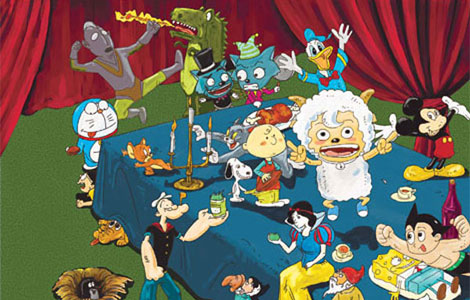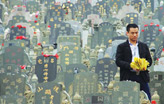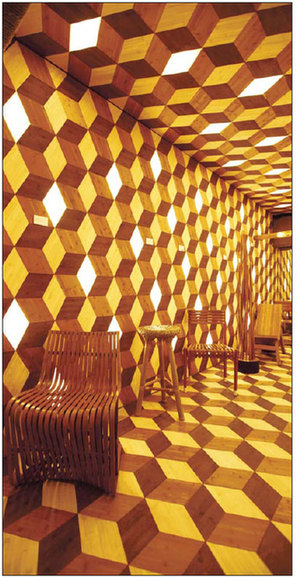Chinese Way
Design matters
Updated: 2011-04-01 07:58
By Zhang Zixuan (China Daily)
|
Jeff Dah-Yue Shi's bamboo house at Beijing Center for the Arts. Provided to China Daily |
More designers, whether in architecture or otherwise, are looking to elements of traditional culture for sustainable ideas. Zhang Zixuan reports.
What will China's design landscape of the future look like? The exhibition Omni-Dimensional Design in China, held recently at Beijing Center for the Arts, offered some answers.
Weng Ling, art director of Beijing Center for the Arts, says the exhibited works reflected growing efforts to encourage design ideas rooted in indigenous culture.
"So-called modern design has had a significant influence on China's society, economy, culture and other aspects in the past 30 years," Weng says. "But with the buzzword changing from 'made in China' to 'made with China', setting up a new standard of design has become imperative."
Led by the "people-oriented" principle, three of the five exhibitors chose architecture as their theme.
Yung Ho Chang, 55-year-old architect, professor of architecture at Massachusetts Institute of Technology, and head of the Graduate Center of Architecture, Peking University, presented an installation to demonstrate his research into the application of fiberglass reinforced plastics (FRP).
FRP has only one-fifth the density of steel, but enjoys the same if not more tensile strength, Chang explains. It also has the advantages of having low energy consumption, being easy to transport and install, and being recyclable.
"In contemporary China, design and fine art are terribly mixed up. As a result, the technical part of design has usually been ignored," Chang says. "But environmental protection and sustainable development cannot be achieved merely by lip service."
He says the lightweight and reusable character of FRP fits the spirit of Chinese traditional wood construction, and his designs attempt to "seek out new ways to bring new technology and materials into the contemporary Chinese culture of design".
A model of an FRP-built house was displayed at the exhibition. Designed by Chang, the real house is under construction in Nanjing, Jiangsu province, and will be completed by September.
Jeff Dah-Yue Shi, 47, a designer from Taiwan, also underscored the importance of sustainability in design.
Shi's bamboo house reflects the Chinese philosophical idea of harmony, not only its natural and simple exterior, but also in the modern designs inside, such as the combination of LED lights and bamboo flooring, and the bamboo furniture.
All the bamboo he used came from Lanxi, Zhejiang province, and was cut between Mid-autumn Day and the Spring Festival, as is customary in China.
Recalling the inspiration for his bamboo creations, Shi mentions what a rescue worker said at the site of destruction in earthquake-hit Taiwan on Sept 21, 1999.
"He said, 'If people were still building houses using bamboo like they used to, we wouldn't be facing this'," Shi says.
He points out that bamboo can absorb 30 percent more carbon dioxide than trees. A forest of bamboo takes only 10 years to form, which is much faster than for other trees, and a bamboo house can stand for more than 50 years, he adds.
"I want more people to grow bamboo and apply it in their everyday life," Shi says.
Taking a different approach, Zhou Wei, 45-year-old architect and artist, explores the aesthetics of a traditional Chinese garden to manipulate space.
Zhou's works present a world of irregular angles and spaces and illusions of doors created by the clever use of lighting. "When a space is folded, squeezed and converted, a new spatial relationship can appear, giving viewers a completely new experience."
Shao Fan, 47, crossover artist and designer, whose architectural work This Is Not a Chinese Garden won the Royal Horticultural Society Gold Award at London in 2008, presented a Ming-style series of installations, he calls "gadget".
The series abstracts, deconstructs and reconstructs the core spirit of Ming-style furniture, and transplants it onto other unrelated objects, such as a beard or bone.
They are made of precious wood, just like Ming-style furniture used to be, and display their creator's sense of the bizarre through their strange combinations.
Shao sees them as playthings, saying that it is "through play that I get a feel of the texture of an object, which then becomes the starting point for understanding the traditional handicraft behind it".
The works of AHA Union, a group of six post-70s and post-80s designers, offer an introspective look at the current situation of China's contemporary design.
They use PVC balloons, rough wall paintings and cheap plastic decorations to express what they see as the main influences on China's modern design.
"Many modern designs are faced with the dilemma of wanting to look like a masterpiece but never becoming one. They are neither an extension of traditional China nor a Western import," says Sun Hua, a member of AHA Union.
Specials

Fill dad's shoes
Daughter and son are beginning to take over the family business of making shoes.

Have you any wool?
The new stars of Chinese animation are edging out old childhood icons like Mickey Mouse and Hello Kitty.

Virtual memorial
High-Tech touches to traditional tombsweeping festival help environment
